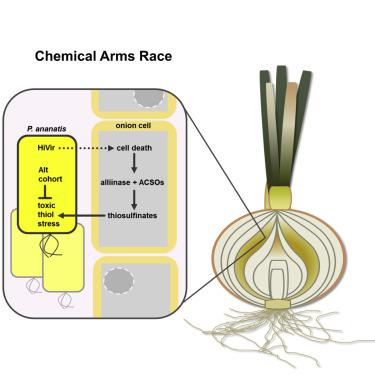Current Biology ( IF 9.2 ) Pub Date : 2020-07-02 , DOI: 10.1016/j.cub.2020.05.092 Shaun P Stice 1 , Kyle K Thao 2 , Chang Hyun Khang 3 , David A Baltrus 4 , Bhabesh Dutta 5 , Brian H Kvitko 3

|
Unlike most characterized bacterial plant pathogens, the broad-host-range plant pathogen Pantoea ananatis lacks both the virulence-associated type III and type II secretion systems. In the absence of these typical pathogenicity factors, P. ananatis induces necrotic symptoms and extensive cell death in onion tissue dependent on the HiVir proposed secondary metabolite synthesis gene cluster. Onion (Allium. cepa L), garlic (A. sativum L.), and other members of the Allium genus produce volatile antimicrobial thiosulfinates upon cellular damage. However, the roles of endogenous thiosulfinate production in host-bacterial pathogen interactions have not been described. We found a strong correlation between the genetic requirements for P. ananatis to colonize necrotized onion tissue and its capacity for tolerance to the thiosulfinate “allicin” based on the presence of an eleven-gene, plasmid-borne, virulence cluster of sulfur redox genes. We have designated them “alt” genes for allicin tolerance. We show that allicin and onion thiosulfinates restrict bacterial growth with similar kinetics. The alt gene cluster is sufficient to confer allicin tolerance and protects the glutathione pool during allicin treatment. Independent alt genes make partial phenotypic contributions indicating that they function as a collective cohort to manage thiol stress. Our work implicates endogenous onion thiosulfinates produced during cellular damage as major mediators of interactions with bacteria. The P. ananatis-onion pathosystem can be modeled as a chemical arms race of pathogen attack, host chemical counterattack, and pathogen defense.
中文翻译:

硫代亚磺酸盐耐受性是洋葱非典型细菌病原体的毒力策略。
与大多数特征性细菌植物病原体不同,广泛宿主范围的植物病原体Pantoea ananatis缺乏毒力相关的 III 型和 II 型分泌系统。在没有这些典型的致病因素的情况下,P. ananatis会在洋葱组织中诱导坏死症状和广泛的细胞死亡,这取决于 HiVir 提出的次级代谢物合成基因簇。洋葱 ( Allium.cepa L.)、大蒜 ( A. sativum L.) 和其他葱属成员属在细胞损伤时产生挥发性抗菌硫代亚磺酸盐。然而,尚未描述内源性硫代亚磺酸盐在宿主-细菌病原体相互作用中的作用。我们发现P. ananatis定植坏死洋葱组织的遗传要求与其对硫代亚磺酸盐“大蒜素”的耐受能力之间存在很强的相关性,这是基于硫氧化还原基因的 11 个基因、质粒携带的毒力簇的存在。我们将它们命名为“ alt ”基因以耐受大蒜素。我们表明大蒜素和洋葱硫代亚磺酸盐以相似的动力学限制细菌生长。该ALT基因簇足以使大蒜素宽容和大蒜素处理过程中保护谷胱甘肽池。独立的alt基因做出部分表型贡献,表明它们作为集体队列来管理硫醇压力。我们的工作涉及细胞损伤过程中产生的内源性洋葱硫代亚磺酸盐是与细菌相互作用的主要介质。在P.ananatis中-onion病害系统可以模拟为病原体攻击,主机化学反击,和防御病原体的化学军备竞赛。



























 京公网安备 11010802027423号
京公网安备 11010802027423号